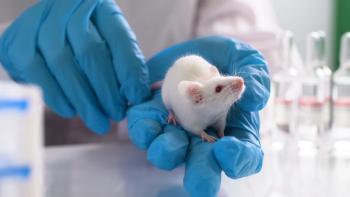Serotonin precursors
Theserotonin precursortryptophan, which is converted to serotonin rapidly in the GI tract after ingestion, can be the main ingredient in over-the-counter dietary supplements. Similarly, neurologic and GI signs are seen most commonly in intoxications. Reported clinical signs include primarily neurologic and GI signs. Neurologic signs consisted of mydriasis, transient blindness, depression, disorientation, hyperesthesia, hyperreflexia, tremors, ataxia, paresis, seizures, and coma. GI signs included vomiting, diarrhea, abdominal pain, ptyalism, flatulence, and abdominal distension. In this report, 7 of 21 dogs developed hyperthermia, and 3 died. The minimum toxic dose was 23.6 mg/kg.16
Treatment and prognosis
Treatment of serotonin syndrome consists of prompt decontamination and aggressive supportive care. Decontamination in clinically normal animals is necessary either via emesis (apomorphine at 0.02-0.06 mg/kg intravenously [IV] or intramuscularly [IM]) or gastric lavage, followed by administration of activated charcoal. Activated charcoal (2 g/kg by mouth [PO]) should be administered every 6 hours in TCA ingestions and ingestions of other medications that undergo enterohepatic recirculation. A cathartic, such as sorbitol, could be administered with the first dose; however, cathartics with magnesium should be avoided in TCA ingestions due to decreased GI motility and risk of magnesium toxicosis.7 Due to the risk of aspiration pneumonia, decontamination methods should be avoided in animals with severe clinical signs.
The intensity of supportive therapy depends on the amount ingested and severity of clinical signs. Animals with GI signs should be treated with antinausea medication such as maropitant (1 mg/kg IV or subcutaneously [SC]) and gastroprotectants such as omeprazole (1 mg/kg PO twice daily) or pantoprazole (1 mg/kg IV twice daily ). Animals with neurologic signs (agitation, tremors, seizures) should be treated with methocarbamol (44 mg/kg IV initially, up to 330 mg/kg total or 132 mg/kg/day PO divided into 2 or 3 doses), diazepam (0.25-1 mg/kg IV as a bolus or 0.25-1 mg/kg/h as a constant-rate infusion [CRI]), or phenobarbital (2-20 mg/kg IV).17-19 Severely hyperthermic animals should be supported by active cooling measures such as evaporative cooling (soaking patient with cool water and directing a fan at them), cold water enemas, and room temperature IV fluid therapy.
Because hyperthermia results from excessive muscle activity, general anesthesia, neuromuscular paralysis (with atracurium at a loading dose of 0.2-0.5 mg/kg IV, then a CRI of 3-9 µg/kg/min), and mechanical ventilation may be considered for severe cases.3,4 Fluid diuresis is not necessary as serotonergic drugs are highly protein bound, but crystalloid fluid therapy is recommended for cardiovascular and renal support, even in patients that are not hyperthermic.5 IV lipid emulsion therapy has been described in human case reports but has not proven to be effective in veterinary species.20
Patients should be monitored for autonomic instability with electrocardiography and blood pressure monitoring. Hypotension should be treated with direct-acting sympathomimetics such as norepinephrine (start at 0.1 µg/kg/min IV and titrate to desired effect).21 Indirect-acting hypotensive medications such as dopamine should not be used due to altered metabolism.3 Hypertension and tachycardia can be present secondary to excessive catecholamine release in MAOI overdoses and should be treated with a short-acting beta-blocker such as esmolol (200-500 µg/kg IV followed by 25-100 µg/kg/min) or nitroprusside (0.5-3 µg/kg/min IV).3,22,23
The use of serotonin receptor antagonists such as chlorpromazine (0.2-0.5 mg/kg IV, IM, or SC every 6 hours) or cyproheptadine (1.1 mg/kg in dogs and 2-4 mg in cats PO every 4-6 hours) may prevent the onset and severity of clinical signs associated with serotonin syndrome.24-26 In rat models, cyproheptadine showed to be more effective, but both drugs prevented death in animals that had ingested higher doses of serotonergic medications.27
Prognosis in patients with serotonin syndrome ranges from good to guarded based on severity of clinical signs, amount ingested, concurrent medications, time to treatment initiation, and type of treatment. For patients receiving aggressive and expeditious treatment, most clinical signs will resolve within 36 hours.
Key points
Serotonin syndrome most commonly results from overdoses of serotonergic drugs such as serotonin reuptake inhibitors, tricyclic antidepressants, and monoamine oxidase inhibitors.
- The most common adverse effects of serotonin syndrome include gastrointestinal deficits, neurologic deficits, and hyperthermia.
- Treatment includes decontamination, supportive care, and administration of a serotonin receptor antagonist such as cyproheptadine.
Jamie Selman, DVM, is a rotating small animal medicine and surgery intern at BluePearl Specialty and Emergency Pet Hospital in Overland Park, Kansas. She hopes to become a board-certified emergency and critical care specialist and is particularly interested in initial stabilization of trauma patients, sepsis, and transfusion medicine.
Heather Towle Millard, DVM, MS, DACVS-SA, is staff surgeon at BluePearl Specialty and Emergency Pet Hospital in Overland Park, Kansas. With more than 15 years of experience, Millard’s veterinary expertise includes advanced soft tissue surgery, oncologic surgery, and general orthopedic surgery. She enjoys mentoring passionate, energetic, and determined young doctors and being part of their journey to success.
References
1. Mohammad-Zadeh LF, Moses L, Gwaltney-Brant SM. Serotonin: a review. 2008;31(3):187-199. doi:10.1111/j.1365-2885.2008.00944.x
2. Thomas DE, Lee JA, Hovda LR. Retrospective evaluation of toxicosis from selective serotonin reuptake inhibitor antidepressants: 313 dogs (2005-2010). J Vet Emerg Crit Care (San Antonio). 2012;22(6):674-681. doi:10.1111/j.1476-4431.2012.00805.x
3. Boyer EW, Shannon M. The serotonin syndrome. N Engl J Med. 2005;352(11):1112-1120. doi:10.1056/NEJMra041867.
4. Isbister GK, Buckley NA. The pathophysiology of serotonin toxicity in animals and humans: implications for diagnosis and treatment. Clin Neuropharmacol. 2005;28(5):205-214. doi:10.1097/01.wnf.0000177642.89888.85
5. Reineke EL. Serotonin syndrome. In: Silverstein DC, Hopper K, eds. Small Animal Critical Care Medicine,2nd ed. Saunders/Elsevier;2015:414-418.
6. Flint C. The usual suspects: Top 10 toxins poisonous to pets. dvm360®. July 7, 2018. Accessed January 25, 2021. https://www.dvm360.com/view/usual-suspects-top-10-toxins-poisonous-pets
7. Johnson LR. Tricyclic antidepressant toxicosis. Vet Clin North Am Small Anim Pract. 1990;20(2):393-403. doi:10.1016/s0195-5616(90)50034-0
8. Shioda K, Nisijima K, Yoshino T, Kato S. Extracellular serotonin, dopamine and glutamate levels are elevated in the hypothalamus in a serotonin syndrome animal model induced by tranylcypromine and fluoxetine. Prog Neuropsychopharmacol Biol Psychiatry. 2004;28(4):633-640. doi:10.1016/j.pnpbp.2004.01.013
9. Indrawirawan Y, McAlees T. Tramadol toxicity in a cat: case report and literature review of seretonin syndrome. J Feline Med Surg. 2014;16(7):572-528. doi:10.1177/1098612X14539088
10. Chu A, Wadhwa R. Selective serotonin reuptake inhibitors. [Updated 2020 Nov 7]. In: StatPearls [Internet]. StatPearls Publishing. https://www.ncbi.nlm.nih.gov/books/NBK554406/
11. Dunkley EJC, Isbister GK, Sibbritt D, Dawson AH, Whyte IM. The Hunter serotonin toxicity criteria: simple and accurate diagnostic decision rules for serotonin toxicity. Q J Med. 2003;96:635-642. doi:10.1093/qjmed/hcg109
12. Pugh CM, Sweeney JT, Bloch CP, Lee JA, Johnson JA, Hovda LR. Selective serotonin reuptake inhibitor (SSRI) toxicosis in cats: 33 cases (2004-2010). J Vet Emerg Crit Care (San Antonio). 2013;23(5):565-570. doi:10.1111/vec.12091
13. Gillman PK. Monoamine oxidase inhibitors, opioid analgesics and serotonin toxicity. Br J Anaesth. 2005;95(4):434-441. doi:10.1093/bja/aei210
14. Brent J. Monoamine oxidase inhibitors and the serotonin syndrome. In: Haddad LM, Shannon MW, Winchester JF, eds. Clinical Management of Poisoning and Drug Overdose. Saunders; 1998.
15. Thomas EK, Drobatz KJ, Mandell DC. Presumptive cocaine toxicosis in 19 dogs: 2004-2012. J Vet Emerg Crit Care(San Antonio). 2014;24(2):201-207. doi:10.1111/vec.12159
16. Gwaltney-Brant SM, Albretsen JC, Khan SA. 5-Hydroxytryptophan toxicosis in dogs: 21 cases (1989-1999). J Am Vet Med Assoc. 2000;216(12):1937-1940. doi:10.2460/javma.2000.216.1937
17. Plumb DC: Diazepam. In: Plumb’s Veterinary Drug Handbook. Wiley-Blackwell; 2015.
18. Plumb DC: Methocarbamol. In: Plumb’s Veterinary Drug Handbook. Wiley-Blackwell; 2015.
19. Plumb DC: Phenobarbitol. In: Plumb’s Veterinary Drug Handbook. Wiley-Blackwell; 2015
20. Dagtekin O, Marcus H, Müller C, Böttiger BW, Spöhr F. Lipid therapy for serotonin syndrome after intoxication with venlafaxine, lamotrigine and diazepam. Minerva Anestesiol. 2011;77(1):93-95.
21. Plumb DC: Norepinephrine. In: Plumb’s Veterinary Drug Handbook. Wiley-Blackwell; 2015.
22. Plumb DC: Esmolol. In: Plumb’s Veterinary Drug Handbook. Wiley-Blackwell; 2015.
23. Plumb DC: Sodium nitroprusside. In: Plumb’s Veterinary Drug Handbook. Wiley-Blackwell; 2015.
24. Mills KC. Serotonin syndrome. A clinical update. Crit Care Clin. 1997;13(4):763-783. doi:10.1016/s0749-0704(05)70368-7
25. Plumb DC: Chlorpromazine. In: Plumb’s Veterinary Drug Handbook. Wiley-Blackwell; 2015. Wiley-Blackwell.
26. Plumb DC: Cyproheptadine. In: Plumb’s Veterinary Drug Handbook. Wiley-Blackwell; 2008. Wiley-Blackwell. Pages 240-241.
27. Nisijima K, Yoshino T, Yui K, Katoh S. Potent serotonin (5-HT)(2A) receptor antagonists completely prevent the development of hyperthermia in an animal model of the 5-HT syndrome. Brain Res. 2001;890(1):23-31. doi:10.1016/s0006-8993(00)03020-1







